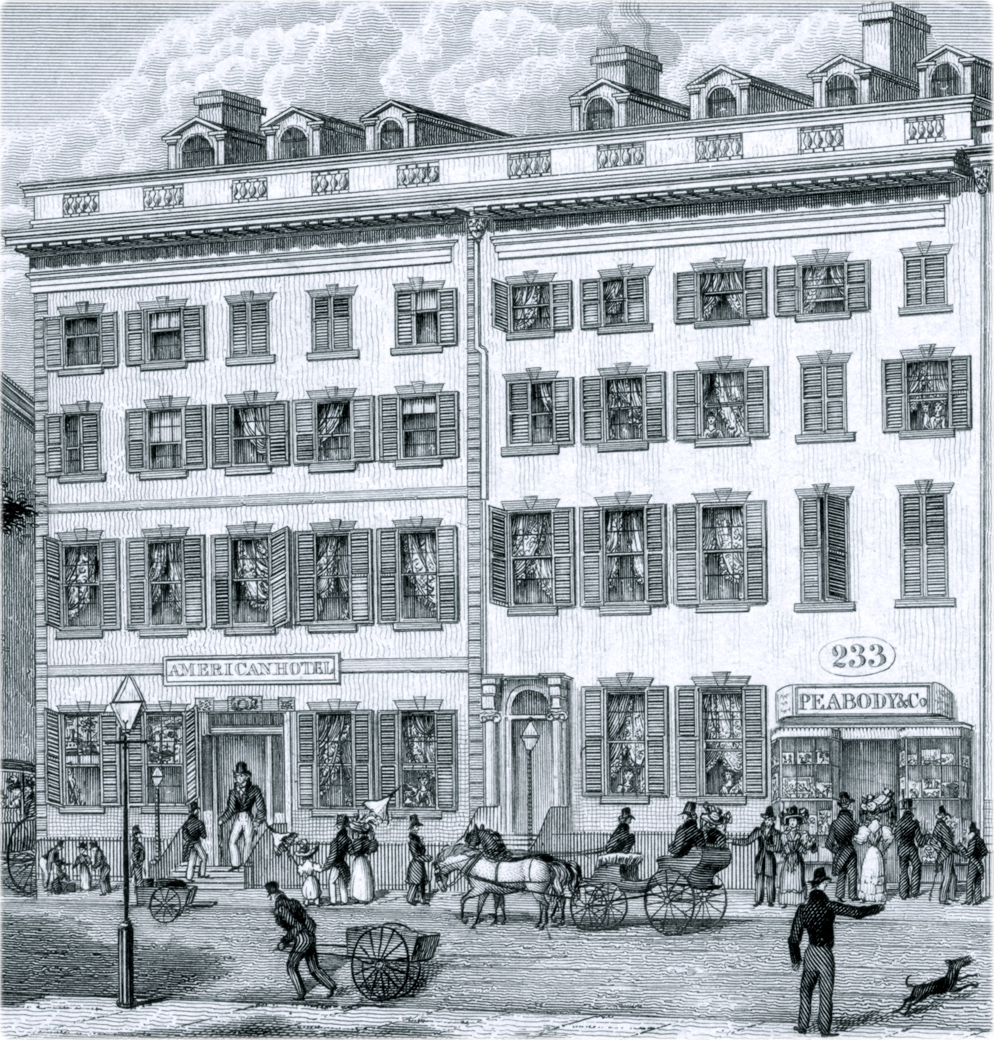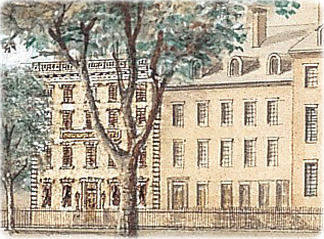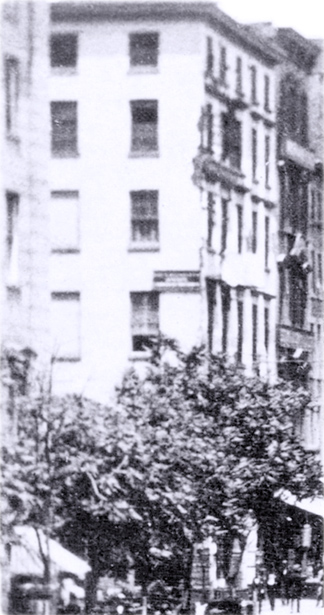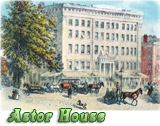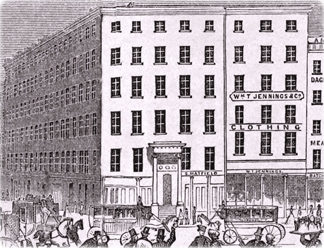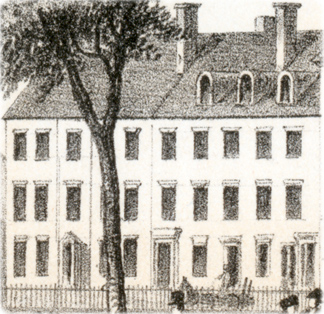The old American Hotel opened in 1825 at 229 Broadway, on the
northwest corner of Barclay Street, facing City Hall Park. It was destroyed by
fire in 1866. According to the New York Times (April 8, 1866), it was once the
Fifth Avenue Hotel of New York, specially from 1825 to 1830.
According to William Alexander Duer (1780-1858), who served as the President of Columbia College from 1829 to 1842, «a double three story house was built by Abijah Hammond [see illustration on the right], at the upper corner of Barclay street, which is still standing, and forms the sub-stratum of the "American Hotel."» (published in the American Mail, July 10, 1847). This double 3-story house is represented in the illustration on the right.
The old 3-story Abijah Hammond house at 229 Broadway, the part on the corner of Barclay Street, five windows large with an attic, was expanded to four stories high. The American Hotel opened in this building on May 2, 1825. It was managed by Boardman & Milford, later by Edward Milford alone.
By 1830, the hotel expanded the right wing of the Hammond house (233 Broadway) to four stories and incorporated it as part of the American Hotel (engraving above). The right wing also housed the emporium Peabody & Co. at 233 Broadway, in the ground floor, in 1828-1831.
It was managed in the 1830s by William B. Cozzens (1787-1864), a former Tammany Hall politico, who kept the Tammany Hotel in 1812. The American Hotel was then considered one of the city's most elegant hotels. Fanny Kemble (1809-1893), the British actress, stayed at the American Hotel in 1832 and she wrote in her diary a sorry account of it, according to the biographer James Parton (1822-1891): «The rooms were “a mixture of French finery and Irish disorder and dirt,” and there was a scarcity, not only of servants, food, and space, but even of such common articles as knives and forks. “The servants,” she adds, “who were just a quarter as many as the house required, had no bedrooms allotted to them, but slept about anywhere in the public rooms, or on sofas, in drawing-rooms let to private families. In short, nothing can exceed the want of order, propriety, and comfort in this establishment, except the enormity of the tribute it levies upon pilgrims and wayfarers through the land.”»
In the 1830s
In 1836, the large luxury Astor House opened on Broadway, on the opposite side of the Barclay Street. The Franklin House opened in 1830s on Broadway, at Dey Street. Others hotels also operated at the time across City Hall Park, on Park Row. This began the American Hotel's decline.
On January 1, 1838, Edward Milford sold out the American Hotel to Cozzens. In the same year, he opened the original Carlton House on the corner of Broadway and Leonard Street.
In 1842, the proprietor Wm. B. Cozzens began a renovation of the hotel. Rev. John McVickar was the owner of the premises. At the time, the firm W. T. Jennings & Co. rented the store in the ground floor of the hotel at 231 Broadway for a clothing store (Drapers & Tailors ), this store was formerly occupied by Madame Berhard, chiropodist.
On June 20, 1843, Cozzens announced in the New York Herald that he had completed the repairs and alterations (started in 1842) of the American Hotel and the adjoining house, which he had annexed to it.
About 1848, William B. Cozzens moved to the West Point Hotel, opened in 1839, and Taber & Bagley (Job Taber of Boston and James Bagley of Philadelphia) became the new proprietors of the American Hotel.
An announcement dated June 8, 1848 by Taber & Bagley published in the Manufacturers and Farmers Journal (June 12) informs that they had leased the American Hotel and "have repaired and improve it throughout. (...) It is their intention to make it one of the best and most fashionable resorts for the travelling public that can be found in this country. Its situation is unsurpassed, being directly in front of the Park and within a short distance of all the steamboat and railroad landings..." On February 26, 1849, the proprietors Taber & Bagley announced in the Charleston Mercury (March 7) that "A new splendid Ladies' Ordinary will soon be completed, also additional rooms on Broadway".
In 1848 or before, the building at 229 Broadway, on the corner of Barclay Street, was expanded to a large 6-story hotel. The annex at 233 Broadway was expanded later to a 6-story hotel, between 1848 and 1851 (see the panorama of 1848). At that time the hotel was no longer considered fashionable.
By 1852, W. T. Jennings & Co., which had a store on the ground floor of the hotel, took possession of the rear extension, which had been used by the hotel as the Ladies' Ordinary (a women-only dining space), and leased the upper portion of the building for eight years. The W. T. Jennings & Co. also made alterations in the front of the 6-story building at 231-233 Broadway.
The handover of the right wing of the hotel to W. T. Jennings & Co. was probably a sign that the hotel was not as profitable as it once was or might be in financial difficulties. In the 1850s, several hotels opened further north. The large Metropolitan Hotel opened in 1852, corner of Broadway and Prince Street. St. Denis Hotel opened in 1853 on Broadway at East 11th Street. The Everett House opened in 1853 at Union Square. Prescott House opened about 1853 on Broadway, corner of Spring Street. The St. Nicholas Hotel opened in 1854, on the opposite corner of Spring Street. Hotel St. Germain opened in 1856 on Broadway at 22nd Street and the Fifth Avenue Hotel opened in 1859 at Madison Square.
On June 16, 1853, the upper stories of the American Hotel, corner of Broadway and Barclay St. were completely destroyed by fire. The water damaged the other floors and furniture. The building was the property of James C. Hamilton, who was thinking about changing the character of the building and construct stores.
In April, 1854, the store of W. T. Jennings & Co. at 231-233 Broadway was discovered to be on fire. The City Hall bell promptly sounded the alarm, but soon after that the entire building was in flames. The firemen was quickly in attendance and several streams of water were played upon the flames, but the building was destroyed and 16 firemen were killed or wounded. The coroner's jury for the case rendered a verdict censuring Charles H. Mountain, architect of the alterations, the mason and the carpenter, and the proprietors Taber & Bagley. The jury also denounced that the building was a mere trap.
Since about 1852, the building at 231-233 Broadway was no longer part of the American Hotel, owned by Hamilton. About four month before the fire of 1854, Hamilton had received an anonymous letter, stating that the American Hotel would be burned. The fire was thought to have been caused by an incendiary.
In the 1860s, the old American Hotel building, at 229 Broadway, was occupied by several offices and stores. The Civil War began in 1861 and severely affected the hotel industry.
In January 17, 1862, a fire broke out on the fourth floor of the building at 229 Broadway, in premises occupied by P.R. Peatt, agent for fire and steam regulator. The fire spread to the story below occupied by George A. McDonald, commission merchant.
On September 29, 1864, a fire broke out in the 5th story of the old American Hotel caused by the explosion of a gas pipe. Damage was very small.
On April 6, 1866, the old American Hotel building, owned by James C. Hamilton, was destroyed by fire. Another six-story building was erected on the site in the same year. The block between Barclay Street and Park Place is now occupied by the Woolworth Building, completed in 1913, the highest building in the world for about 17 years.
